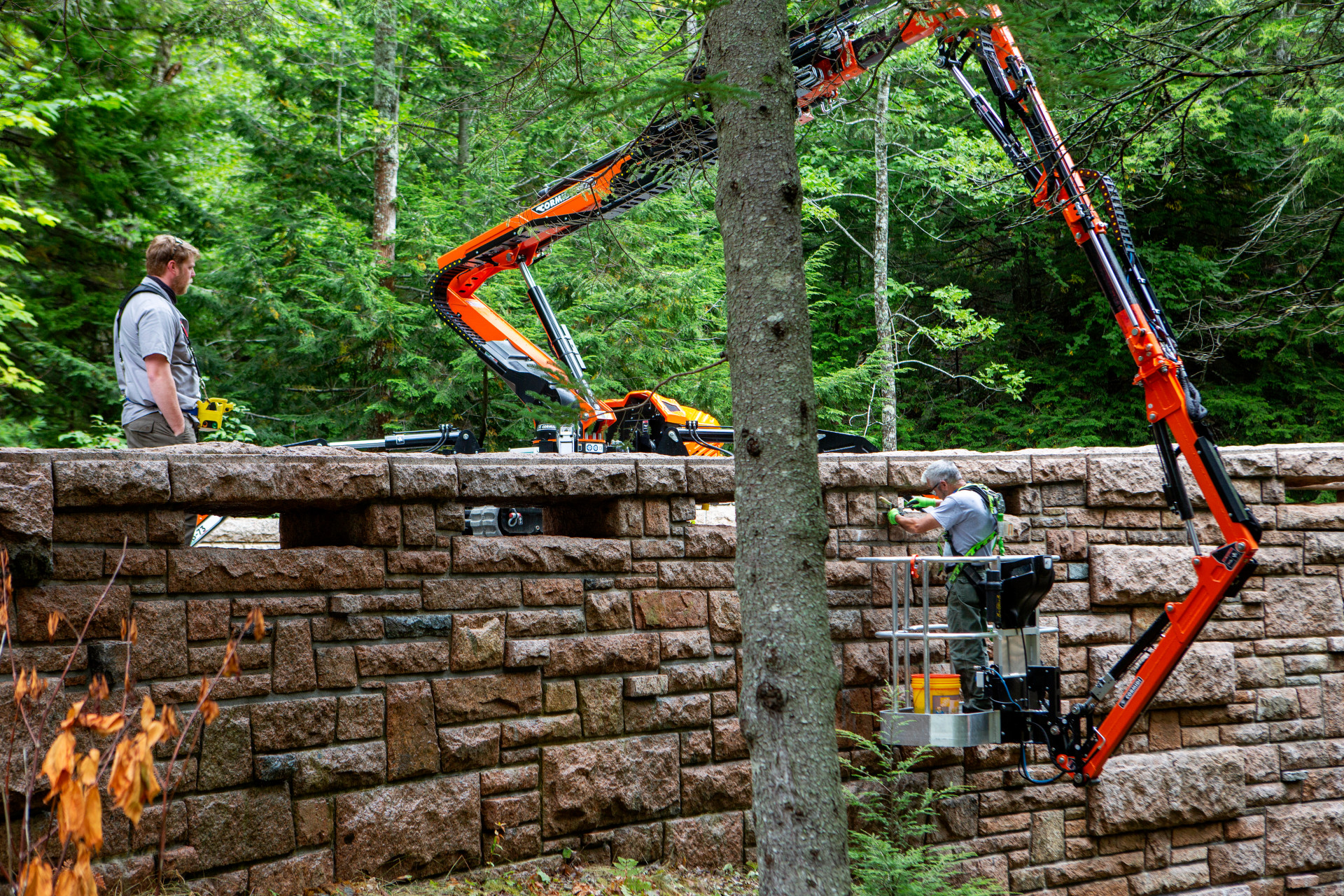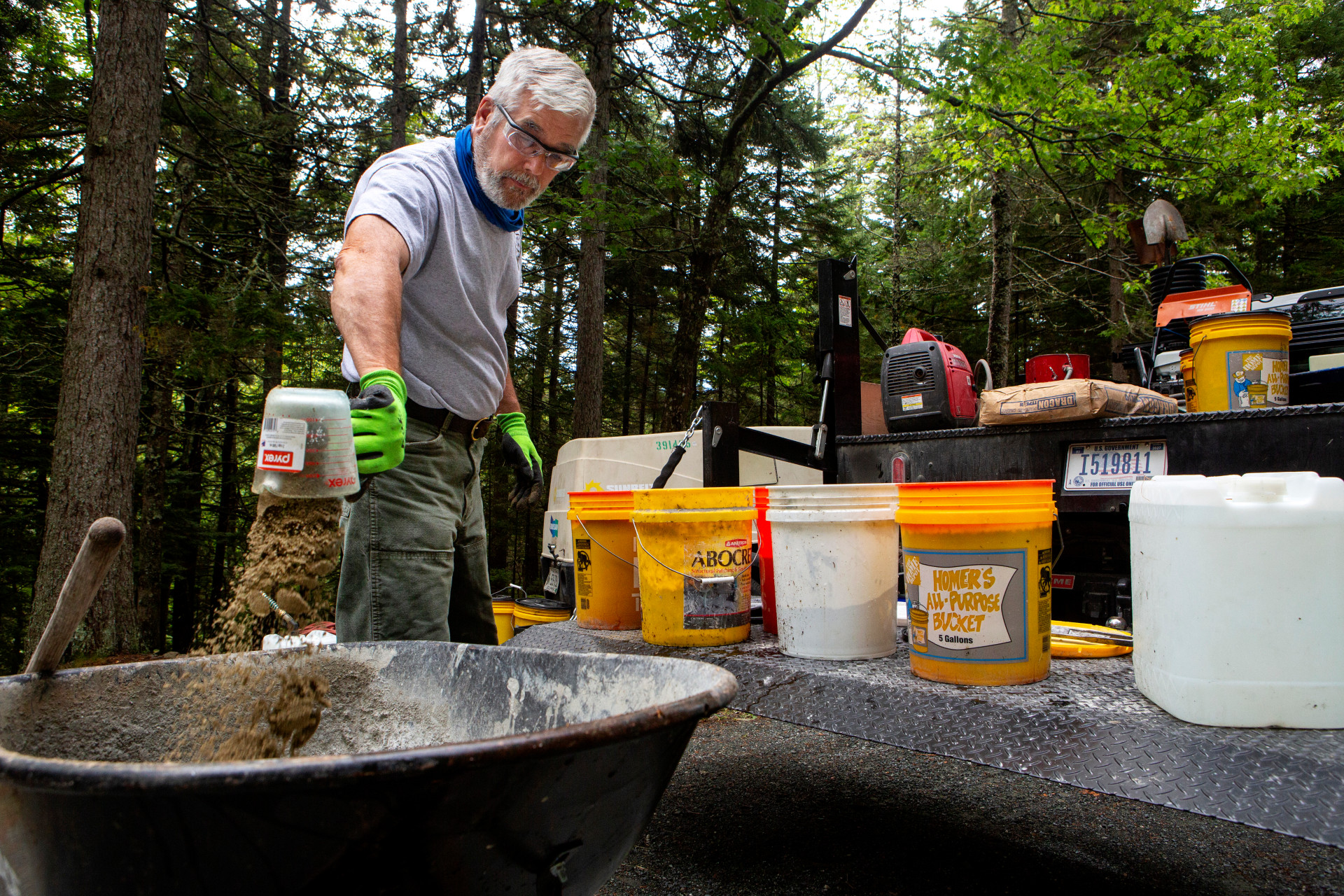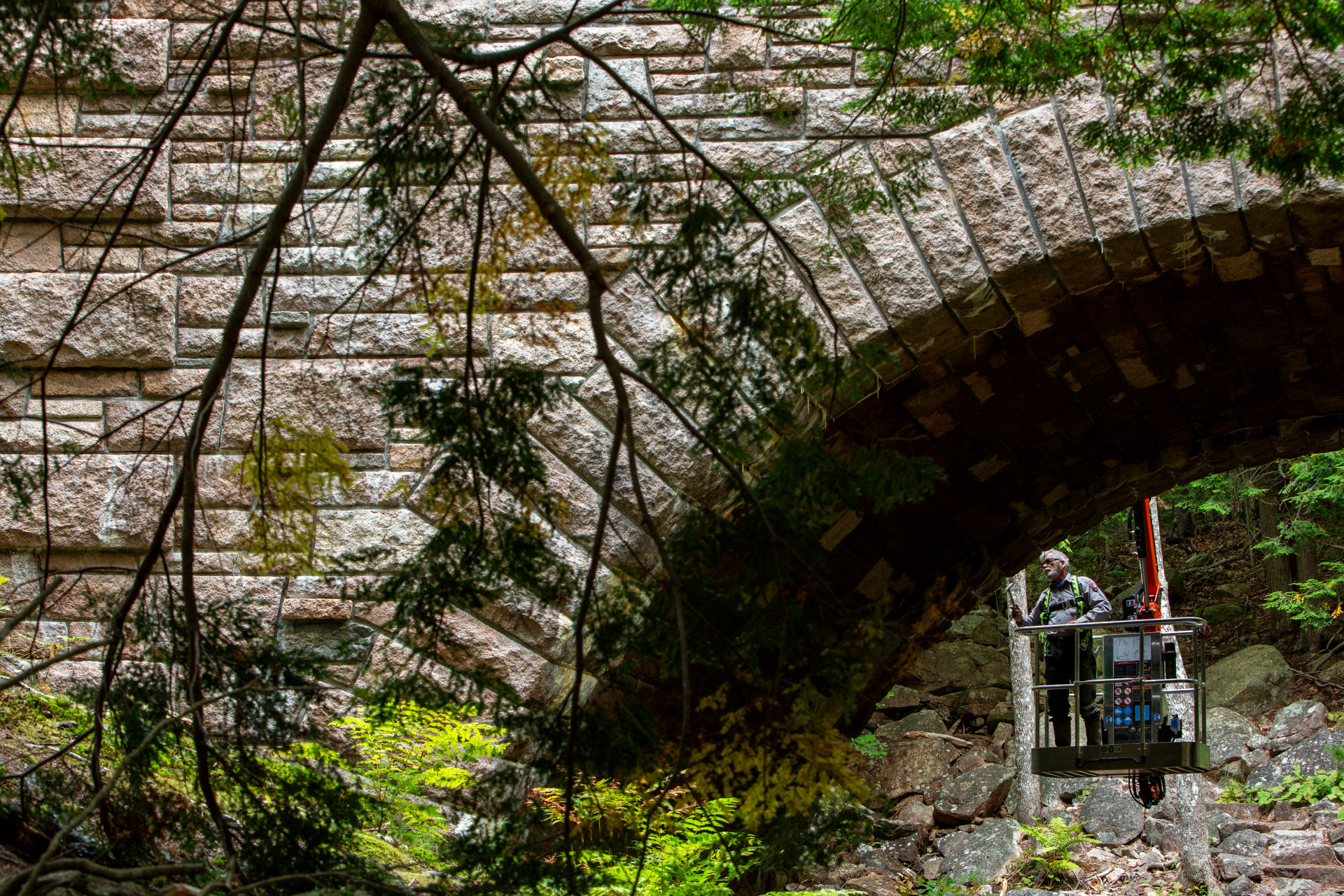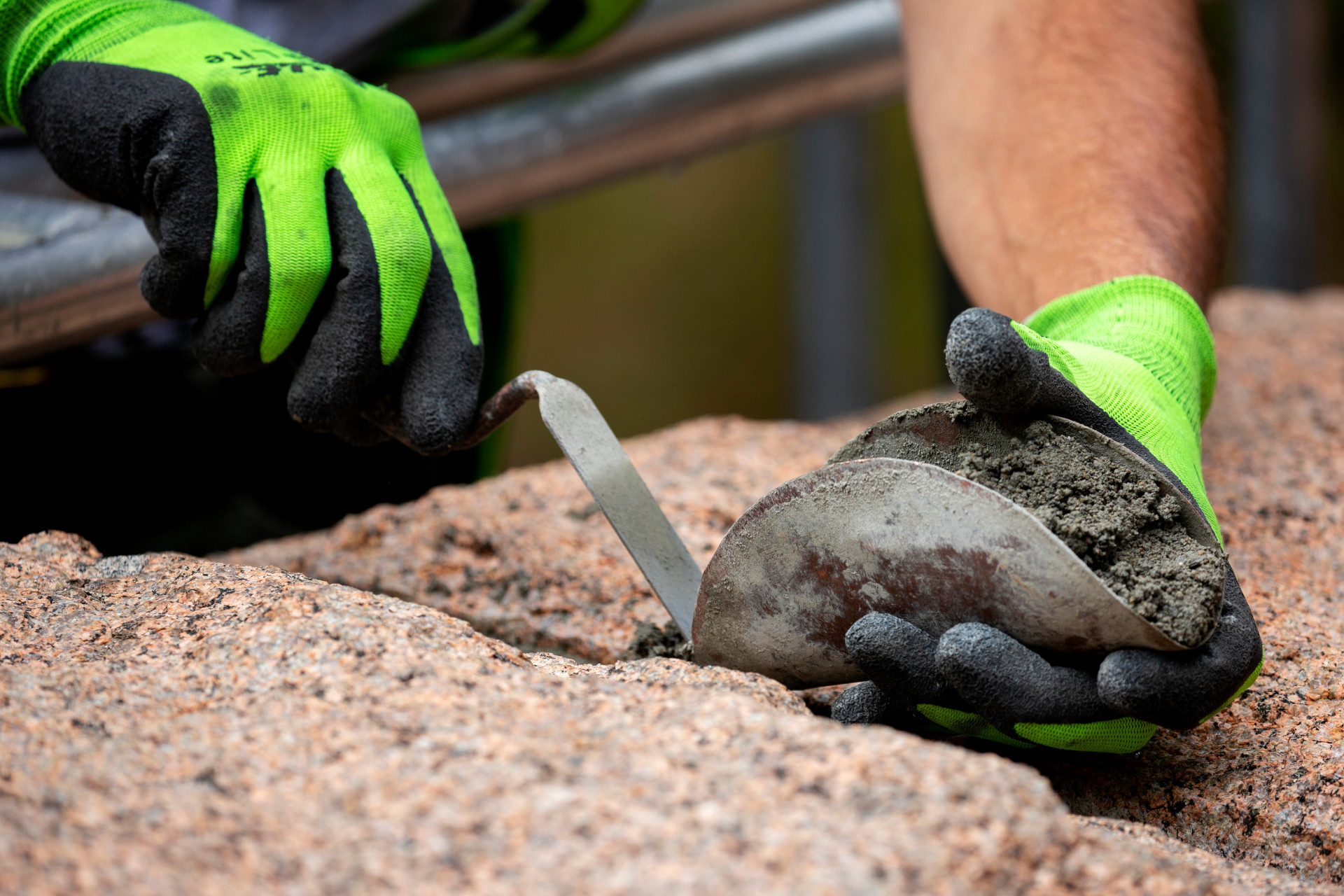Forever Young
Acadia’s Masons Toil to Preserve Landmarks
May 12th, 2021
Acadia’s Masons Toil to Preserve Landmarks
May 12th, 2021
In Acadia, no other human-made structures are as iconic as the historic bridges on the the carriage roads.
John D. Rockefeller Jr. financed 16 of the 17 stone-faced bridges, each unique in design, to span streams, waterfalls, roads, and cliffs. The stonecutters and masons who constructed the bridges were experts in their field, artists really. It is said that Rockefeller often requested they avoid cutting the facing too well or the bridges might lose their rustic appeal.
Because local stone was used for the bridges, they appear to emerge from the landscape itself. The bridges are so impressive in stature that when one bikes, walks, rides, or skis along the carriage roads, and gazes upon these edifices, it is hard to believe they need maintenance and upkeep. But they do, and Acadia National Park employs two full-time masons to help preserve the park’s historic stone structures.
Acadia Master Mason Mike Fitzpatrick began working for the National Park Service after a 20-year career in Manhattan with Stone Setter’s Union (Local 84.) In New York, he worked on stone exteriors – granite and limestone mostly. He spent much of his time anchoring and weatherproofing buildings, some as high as 55 stories.

Acadia National Park Mason Mike Fitzpatrick (right) adds a mortar mixture to the grout in the Amphitheater Bridge while Acadia National Park Mason Tender Bryan Meddaugh controls the machinery to allow Fitzpatrick to reach the spots he needs.(Photo by Ashley L. Conti/Friends of Acadia)
Living on Long Island and dealing with traffic and congestion daily began to wear on Fitzpatrick. He decided to move to Tennessee to be closer to family. There, he received an opportunity to work at Cumberland Gap National Historical Park as a part-time mason and was later hired as a full-time “jack-of-all-trades” in addition to his masonry work. Five years ago, he moved to Maine with his family to work in Acadia as the full-time master mason.
Fitzpatrick says that one of the significant differences between his work for the Park Service and in New York City is the time dedicated to ensuring historical accuracy in restoration projects. “In New York, it was always ‘hurry up and get it done’; it was all about the bottom line. With the Park Service, it’s about taking care to preserve what these bridges are and restore them as closely as possible to what they were originally.”

Acadia National Park Mason Mike Fitzpatrick uses a measuring cup to make a precise mortar mixture to the add to the grout in the Amphitheater Bridge in Acadia National Park. (Photo by Ashley L. Conti/Friends of Acadia)
In 2002, in an effort to preserve and catalog the original mortar, samples were taken from 15 bridges. These samples are permanently stored as part of the park archives. The archiving and cataloging of original building materials ensures that employees performing restoration work will have access to the samples and information in perpetuity to serve as guidelines for historic accuracy in cultural resource restoration projects.
Mortar samples from the bridges were also sent to two engineering firms for chemical testing to determine the makeup and structural properties. The findings showed the sand and stone used in the original mortar was local, and there was minimal degradation to sections shielded from the elements. This was a relief to park staff as it reaffirmed the bridges’ structural soundness. This meant sections of mortar close to the facade were the only areas that might need restoration work.

Acadia National Park mason Mike Fitzpatrick checks the integrity of the grout at the Amphitheater Bridge in Acadia National Park, Wednesday, September 9, 2020. (Photo by Ashley L. Conti/Friends of Acadia)
Acadia’s bridges are most vulnerable to damage near parapets and capstones, which are especially susceptible to snow and ice accumulation. When snow and ice melt at the top of the bridges, the water seeps into cracks. When the water refreezes, it expands and can further damage mortar and even the stone itself. According to Fitzpatrick, 99 percent of this damage occurs near the bridges’ exposed tops; the material from the road level down is the original mortar that has not needed repair.
Protocols for bridge maintenance and preservation have changed over the years. When Fitzpatrick first began, the protocol did not include pressure washing the lichen and moss off the bridges. “It doesn’t look like lichen could do much harm, but over time the lichen will work its way into the granite, and the stone will begin to flake and crumble away,” he says.
Park staff initially considered lichen and moss as part of the bridges’ historic characteristics – almost like a patina. But once it was discovered how much damage could be done, the protocol changed. “The park service is always open to suggestions from the observations of its staff, and because of this, protocols can be changed and updated as time goes on. There wasn’t much collaboration like that when I worked in New York;’ Fitzpatrick says “Here it’s a team effort and we have a great team. Everyone works together to save and preserve these bridges and structures.”

Acadia National Park Mason Mike Fitzpatrick and Mason Tender Bryan Meddaugh work to clean and repair motor on the bridge using a mixture similar to the original. (Photo by Ashley L. Conti/Friends of Acadia)
To ensure accuracy, masons painstakingly create several “mortar boards” for color and texture. The board that most closely matches the historic mortar sample in the archive determines the ratio of sand, lime, and aggregate. “We give this information to the park, and they keep it on file so that whoever comes to do this when we’re gone will have the information about the exact composition they need to make to keep things historically accurate;’ says Fitzpatrick. Inaccurate colors or textures make a repair job stick out from the untouched section of bridge.
Fitzpatrick says he feels connected to the masons who built the bridges more than 100 years ago. “It makes me think about the work I did in New York building new construction. I try to compare it to the work that was done here, and I’m just amazed when I think about it.
“I have a vision of these masons and how rugged and tough they must have been. The kind of machinery and equipment we have now is so advanced. They had to build their own scaffolding from scratch on this rough terrain. I don’t know how they did it. These were some talented and tough masons,” Fitzpatrick comments.
“When people come by and see us restoring the bridges, they usually just assume we are buying a generic bag of mortar mix. They often don’t realize it’s a whole process. When we explain all the steps we are taking for historic accuracy, we get a lot of compliments and thank-yous.
“People really seem appreciate the work that is being done,” he says. “It’s gratifying. I love working in Acadia. It’s my favorite job by far. Working outside every day isn’t for everybody, but I love it, and I’d much rather be here in this park than on 3rd or 2nd Avenue in Manhattan dodging traffic.”
About half of Acadia’s bridges have been restored, Fitzpatrick says. When preservation work on the final bridge is completed, the team will go back to the first bridge again and start doing inspections to see how well the mortar has held up and if more repairs are needed ― the work of an Acadia mason is never done.
Fitzpatrick says that when he’s gone, Ryan Meddaugh, the Acadia mason helper, will most likely take over. “He will train the next person who will eventually take over the position,” Fitzpatrick explains. “That’s what you do, you pass it down, so these beautiful bridges are here forever.”
Maintenance of the carriage roads is funded by the Friends of Acadia Carriage Road Endowment. The restoration of the carriage road bridges is sponsored in part by donations from the 2019 Friends of Acadia Annual Benefit Paddle Raise.
JULIA WALKER THOMAS is Friends of Acadia’s Digital Media Manager